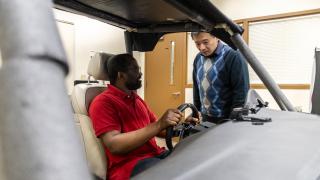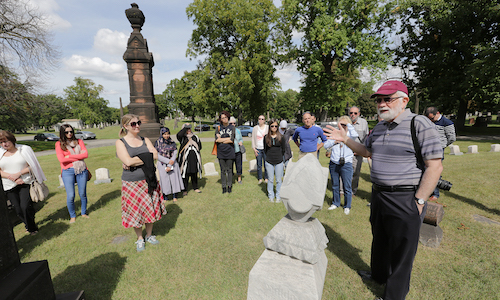
In research, symbols are important. Parentheses enclose and set off material from the main text. Superscript numbers signify a footnote. And, in Professor Ron Stockton’s research, a dash indicates a lifetime.
For nearly 20 years, the political science educator has been traveling to cemeteries from Dearborn to all around the world—Oman, Spain, Scotland and more—to research and give that dash a bit more meaning.
“Sometimes a lot happened, sometimes a little. But, with that dash, there is always a story,” he said. “With more and more stories disappearing with every generation, I wanted to do my part to document what I still could.”
Stockton’s interest in cemeteries didn’t begin with research in mind. It grew out of a series of Decoration Day, or Memorial Day, celebrations he attended as a youth with family in his small southern Illinois town.
Stories passed down to a young Stockton of people long gone—coal miner family members who provided fuel for locomotives and a great uncle who was a devoted military man killed during World War I—gave the stone-marked plots meaning.
“I grew up visiting the cemetery since before I could remember. No one shared any idea of it being evil or creepy. It was an interesting place that was both a memorial for our families and an important part of my hometown’s history,” he said. “That’s how I hope others see cemeteries too.”
History, unearthed
A teaching award received in the early 2000s allowed Stockton’s academic career and cemetery interest to unite. He took the monetary prize associated with the award and turned the research he had done on that family cemetery—Horse Prairie Cemetery—and the inventory independently collected by Clara Crocker Brown, a lifelong resident of the town, into a book.
“I remember [Provost Emeritus and Professor of Biology and Environmental Science Emeritus] Robert Simpson asking me what I was going to do with the money,” he said. “I told him, ‘It’s going to be a graveyard book.’”
Of the 829 graves in the cemetery, Stockton noted any personal messaging on the stone, traced family histories and shared brief stories about an individual that others had passed down.
Of the 683 that had both birth and death dates, he also analyzed mortality patterns. While there is no information on the cause of death in those cases, "the pattern of burial itself gives insight into the nature of life and death in an earlier time," he said.
For example, in the early 1900s, adding health education to schools increased life expectancy, for children in particular. In the 19th century, more than half of all burials were children under 10 years of age. Within 40 years of the public health education initiative, burials of people younger than 10 were less than 20 percent.
Discoveries like this—gathering this unwritten history about the time when his ancestors lived by combining existing information—encouraged him to conduct research at other cemeteries.
He has since published several academic papers. His most recent work is “Muslim Gravestones in Detroit: A Study of Tradition, Diversity and Adaption,” which focuses on 65 southeast Michigan graves with various cultural markings—including Bosnian, Lebanese, Chinese, Albanian, Pakistani and African-American.
Stockton also has had speaking engagements at national conferences, curated art shows, given community lectures on local cemeteries, created courses for students, and led cemetery tours.
And he’s noticed that people are just as curious as he is.
The Horse Prairie Cemetery data that started this area of his research still gets hundreds of downloads each month. The Graveyard 101 public lectures have always been full. And students in HIST 263:Western Civilization—in which Stockton takes the class on a cemetery tour—give positive feedback on their experiences.
“A cemetery is a way to view years and years of history,” he said. “I share stories about specific people to contextualize it. Then it’s not a place with dead people. It’s a place where people who shaped our community reside together.”
Reflect and respect
Stockton takes the class to the historic Woodmere Cemetery to explain the significance of Detroit’s past. He said many of his students had not set foot in a graveyard prior to the course.
There’s the United Auto Workers monument that memorializes the 1932 Ford Hunger March victims, who were shot in an unarmed march asking for labor demands to be met.
There’s a modest flat stone that marks the resting place of Temple Beth El Rabbi Leo Franklin, who was known for his 40-plus years of interfaith and cultural work in Detroit and establishing a student congregation, the forerunner of the Hillel Society, at the University of Michigan.
And there’s a section the American Moslem Society owns—it was purchased by the organization in the 1930s—that faces the oldest Mosque in the state.
“There are always a few students who are nervous before the tour because of misconceptions of what a cemetery is. After the tour, students tell me how they see the graveyard differently. They have a transformative moment. They see that it is not about death. It is about celebrating life.”
And Stockton said instilling a message of respect is as important as his educational one.
Just as he did as a boy for his family plots at Horse Prairie Cemetery in preparation of Decoration Day, Stockton said he still clears away debris. And he encourages others to do the same.
“If you see someone not taking care of a stone, clear that sucker off. Rip the grass away so that the stone could be read again,” he said. “It is important to learn about our history, learn from our history and learn to be respectful of our history. A society that will not take care of the dead, does not take care of the living.”



